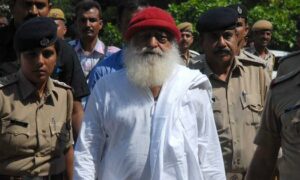
Salman Rushdie’s new collection of short stories urgently recollects his literary legacy. It’s as though time is increasingly uncertain so the need to tell stories is great.
Its title, The Eleventh Hour, says as much, and the book succeeds Knife (2024), written about his attack on stage in 2022. The central story portrays students and writers in the libraries of English literary history. Two stories set in India consider the entangled states of faith and doubt. The final two tales are set in America, employing stylistic innovation to address grand questions about authenticity, censorship and fraud.
The story “In the South”, first published in the US magazine The New Yorker, questions the logic of death and ageing. Written after the 2004 Indian Ocean earthquake and tsunami estimated to have killed 250,000 people, it introduces two elderly neighbours and their encounters with relatives and neighbours.
Typically, Rushdie in structural and narrative prowess it portrays the astounding everyday. Recalling stories in his earlier collection East, West (1995), it is a close character study ,interrogating the minute but asking huge questions.
Nicknamed Junior and Senior, the neighbours’ only similarity beyond their interdependence is a shared (undisclosed) first name. While Junior is hopeful and serene, Senior is melancholy and cynical. And though Senior has a vast, attentive, unwanted family, Junior is alone.
A phrase in this story gives the collection its title and alerts us to the book’s preoccupation with older age. The story comes to terms with death, however unfathomable, by understanding it as an “adjacent verandah” to life.
Where to start with the collection
For readers new to Rushdie, “The Musician of Kahani” is the story to read first. Ranging over several decades, its young female protagonist possesses magical talents comparable to the protagonist of Midnight’s Children (2008), Saleem Sinai. This was the book that cemented Rushdie as a globally significant author.
“The Musician of Kahani” indulges in renaming – one of Rushdie’s preoccupations. Mumbai becomes Kahani (meaning story) and its streets are renamed, enjoyably, after literature: William Shakespeare Bunder, Dahl Market, Petit Prince Parade. Events pivotal to the plot are handled out of sequence, presented like delightful gossip and we understand plot is incidental: storytelling is what matters.
The third story in the collection, “Late”, is set in an Oxbridge college. Simon Merlyn (SM) Arthur is the “late” protagonist of the title. The honorary college fellow and renowned novelist of a single book, he wakes to find himself unexpectedly dead at 61. Unmoved, he ponders the nature of the mind and body, life, death and the afterlife.
The story assembles cliches of England: Oxbridge, the Second World War, contingent multiculturalism, colonialism’s falsely genteel face and the weather. However, it is also about English literature, myth and legend, and rejuvenation. Set “50-something” years ago, it reveals an author prevented from achieving his potential.
Rosa, an undergraduate from India entrusted to organise SM’s papers, can communicate with his ghost, and uncovers sadness and betrayal. Rosa is a version of Rushdie, perhaps: the story is peppered with anecdotes from his life, including advertising slogans (Rushdie was an advertising copywriter famous for “Naughty But Nice”). Rosa also stumbles upon transformative archival materials. In Rushdie’s own experience, these materials inspired his novel The Satanic Verses (1988).
The two final stories, “Oklahoma” and “The Old Man in the Piazza”, are set in the US and both are experimental, particularly Oklahoma.
Oklahoma is an unedited posthumous autofictional manuscript and a literary conversation between author MA and an acclaimed writer affectionately named Uncle K. What begins as an adventure in literary benefaction descends into uncertainty, deception and obsession.
MA is encouraged to complete the story of Kafka’s Karl Rossmann in Amerika (1927), who never attained fulfilment since he failed to reach Oklahoma. Instead, he presents manuscripts of uncertain authorship, including an 1819 tale of murals depicting anguish and despair in response to corruption, violence and ignorance sanctioned by controlling storytelling. These paintings also target old age, represented as death, rage, insanity, jealousy and hate.
How to read
The experimental story ponders obsession, incompleteness and falsehood as more of Rushdie’s preoccupations emerge: The Wizard of Oz, Alice in Wonderland, disappearance, and global relocation.
While “In the South” makes peace with death as a facet of life, and “Late” shakes off the torment of life’s regrets, secrets and betrayals for a fruitful afterlife, “Oklahoma” is bleaker. Here, life is incoherent, and truth is only achieved by death.
The collection begins and ends with old men whose bodies are frail and inflexible. “The Old Man in the Piazza” is the final story, beginning with an elderly man who sits watching impassioned and aggressive conversations around him. In this fable about the folly of repression, the beauty and poetry of language are forgotten in favour of thumbs-up or down moralising.
The stories in The Eleventh Hour tell Rushdie’s life story in metaphorical glimpses. This may be better received than his memoir, Joseph Anton (2012), which was described by reviewers as too long and too focused on celebrity. These stories convey Rushdie’s literary life, and through them we are reminded of what has been termed “his brilliant early phase”, a phase that, as these stories show, is rarely disturbed.
Jenni Ramone is Associate Professor of Postcolonial and Global Literatures, Nottingham Trent University.
This article first appeared on The Conversation.
📰 Crime Today News is proudly sponsored by DRYFRUIT & CO – A Brand by eFabby Global LLC
Design & Developed by Yes Mom Hosting






